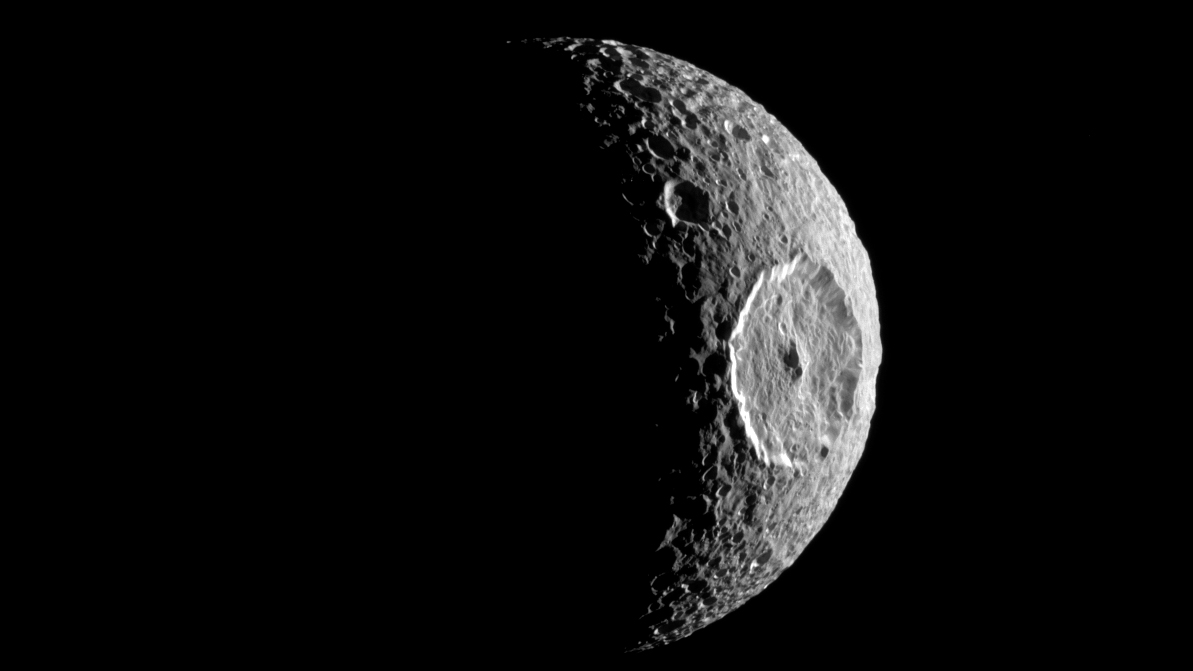Saturn's 'Death Star' moon could have a secret underground ocean
Life in our solar system could be far more likely than it first appeared.

Scientists have found "compelling evidence" that Saturn's "Death Star" moon is hiding an ocean just beneath its surface, furthering the search for possible life in our solar system.
Researchers say that Mimas, Saturn's smallest, innermost moon — whose resemblance to Star Wars' infamous battle station inspired its nickname — revealed the first clue that it could be a "stealth ocean world" after NASA's Cassini probe spotted a strange wobble in the moon's rotation.
Now, new research published Jan. 19 in the journal Icarus suggests that the wobble could be the result of the sloshing of a liquid ocean trapped just beneath the icy surface of the 246-mile diameter (396 kilometers) moon. If this is the case, researchers say that Mimas is an entirely new type of world. The discovery of the tiny moon's secret ocean could mean that water, and the possible life it can sustain, could be far more abundant in our solar system than first thought.
Related: Moon birth and methane weather: Cassini's 7 oddest Saturn finds
"If Mimas has an ocean, it represents a new class of small, 'stealth' ocean worlds with surfaces that do not betray the ocean's existence," study first author Alyssa Rhoden, a geophysicist at the Southwest Research Institute in San Antonio, Texas, said in a statement.
Interior water ocean worlds (IWOWs), such as Saturn's Enceladus or Jupiter's Europa, are not new to scientists, but inner tidal processes tend to fracture their surfaces and they show other signs of geological activity. Mimas, on the other hand, looked at first glance like it was "just a frozen block of ice," Rhoden said.
"Turns out, Mimas' surface was tricking us, and our new understanding has greatly expanded the definition of a potentially habitable world in our solar system and beyond," she added.
Get the world’s most fascinating discoveries delivered straight to your inbox.
To investigate the possibility of a hidden ocean under Mimas' frozen surface, the researchers built a model to see if its gravitational interactions with Saturn could produce the tidal forces necessary to heat the moon's interior, keeping the water below its 15- to 20-mile-thick (24 to 31 km) exterior ice shell warm enough to remain liquid.
"Most of the time when we create these models, we have to fine-tune them to produce what we observe," Rhoden said. "This time evidence for an internal ocean just popped out of the most realistic ice-shell stability scenarios and observed librations [planetary wobbles]."
The findings make Mimas a "compelling target for further investigation," Rhoden said. By studying the moon's ability to support an ocean, scientists could glean a better understanding of other potential hidden ocean moons tucked farther out in our solar system, such as the moons of Uranus.
Originally published on Live Science.

Ben Turner is a U.K. based staff writer at Live Science. He covers physics and astronomy, among other topics like tech and climate change. He graduated from University College London with a degree in particle physics before training as a journalist. When he's not writing, Ben enjoys reading literature, playing the guitar and embarrassing himself with chess.
